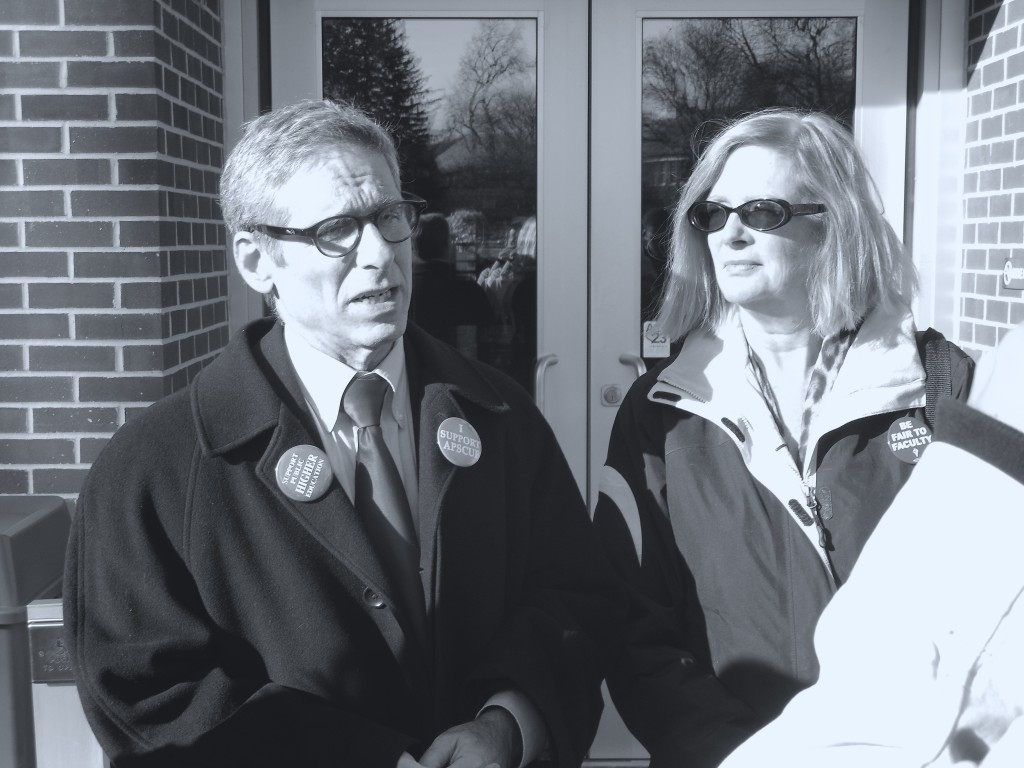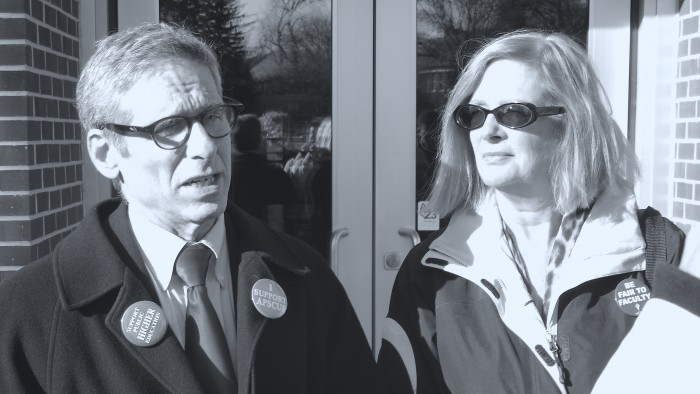

Photo Credit / Jamie Reese
BY VICTORIA KRUKENKAMP
Managing Editor
Hostility between the APSCUF faculty union and ESU administration had reached a boiling point at the end of the Fall 2013 semester, but the atmosphere on campus has changed in 2014.
“I think over the holidays — I think the refresh button was hit was hit by both sides,” said Ken Long, ESU’s Vice President for Administration and Finance.
APSCUF faculty and administrators both point to the state level Meet and Discuss that occurred on December 11, 2013, as a session that began to change the tides.
The state level Meet and Discuss is one that occurs for every PASSHE school that is considering retrenchment, but this was the second session of ESU.
“According to out collective bargaining agreement (cba), retrenchment must be brought before Meet and Discuss, at both the state and local levels, to consider alternatives,” wrote Dr. Allan Benn, Distinguished Professor of English.
As the meeting progressed, much of the budgetary issues that the two sides disagreed on were covered –– which caused tension to rise.
“It was especially clear to the OOC (Office of the Chancellor) people that hostility at ESU was greater than at the other schools facing retrenchment. To calm things down, the administration team called a caucus — a sort of time-out when one of the two sides leaves the room so there can be confidential internal discussions,” wrote Benn.
Benn explained that the result of the caucus was that both sides agreed to continue Meet and Discuss sessions on campus into the Spring 2014 semester.
Dr. Nancy VanArsdale, English department chair and local APSCUF president explained that the biggest take-away from the meeting was that “people on the state level argued for (the University) to find a better way—new ideas for cutting the budget.”
Dr. John Hauth, Chair of the Athletic Training Department, reflected on the new direction that the state Meet and Discuss session set ESU towards.
“I think coming out of it, what we realized and what we all agreed to was that we need to get back to East Stroudsburg and we need to get a smaller group around the table. We need to think about how we can dig out of this—and dig out of it together,” said Hauth.
Hauth is realistic in his expectations for the weekly Meet and Discuss sessions on the ESU campus, but he is also pleased with the direction that the sessions have taken.
“Even though we’re going to have some differences of opinion, in terms of how we might achieve this,” Hauth continued, “there was a much different feeling around the table in terms of ‘let’s roll our sleeves up and let’s listen to one another carefully’ and try and come up with some things.”
This all resulted in weekly meetings between ESU APSCUF leaders like VanArsdale, and ESU Administrators — including Long.
VanArsdale described the meeting as having a “change of tone.”
They are “really trying to come up with ways to generate revenue,” continued VanArsdale.
ESU budget deficit is a very real problem for the coming years, especially with PA Governor Corbett passing a flat budget for state higher education.
“We’re still looking at a — well actually the original number was $7.6 million — we’re still working with that number,” said Long.
This means that the October 30 retrenchment announcement will not be revised.
“Retrenchment has already taken place,” said Long. “The idea now is — are there things that we can do corroboratively that will be able to change a job here a job there? As I said to the union, even if what we’re doing here saves one job — that saves a job. And that’s still my intention — to say ‘what can we do working together that can possibly change the outcome of a position?’”
“For example, if there’s a faculty member that retires in one of those departments, say chemistry for example, that could save a job,” continued Long. “That means we bring a person back. If there’s things that we can do that will allow us to work together that will change the budget projections that could save a job, lets do that as well.”
The weekly Meet and Discuss sessions on campus are intended for just that purpose — to discover what cost saving measures can be taken at ESU.
Dr. Doug Lare Professor of the Professional and Secondary Education Department reflected on the tone of the meetings.
“We all love [ESU] so we all want to work together to try to make sure that the message gets out that we’re trying to solve problems so I think productive is more the tone right now.”
Part of the cost saving options that are under review at the meetings are the plans that were presented by the departments that were under consideration for retrenchment last semester, and Lare is one of the members who is responsible for finding the dollars in those plans.
“We’re responsible to go over all those plans and sort of tease out the cost saving possibilities,” said Lare. “The departments took it very seriously in terms of trying to come up with creative ways for cost-cuts. I’m just staring to do that now.”
Some of the proposed ideas are a more comprehensive summer school that is more cost effective, a more profitable night school program, non-credit/community enrichment programs, team-teaching, and the combination of departments where student learning would be enriched by such a merge.
“We’ve dusted off and polished ideas,” said Hauth, who also indicated that he believes alumni engagement and the changes to the ESU Foundation would be a great benefit in the process of salvaging the budget.
A major discussion for the group has been how to increase enrollment and retention at the university—and all parties agree that the efforts extend beyond the admissions office.
ESU’s enrollment is only down 2.38 percent according to figures released by the Office of the Chancellor on Friday. This is something to take pride in, according to Benn.
“Both the administration and the faculty should share credit for keeping enrollment losses down in a difficult demographic time,” said Benn.
The meet and discuss group is exploring ways that faculty can be more involved with the admission process to keep ESU trending in the right direction.
That’s one difference in the tone that Lare outlined—a “resurgence in seeing faculty as a resource.”
In his role, Long is open to all possibilities.
“If there are things that we can do that will have a meaningful impact—I’m all for it,” said Long.
President Welsh, though not an active member of the sessions is aware of the discussions and hopeful for their outcomes.
“We would not be doing this if she didn’t give me the green light to do it,” said Long. “She was the one that gave me the authorization to have these discussions, to work with APSCUF, to see what we could accomplish in a smaller group.”
“Dr. Welsh is 100% behind it and she’s actually looking forward to what we come up with because this is not good for her. She’s only been here a year and a half, and she doesn’t take any joy in retrenchment,” said Long.
Last Thursday’s Meet and Discuss was cancelled due to inclement weather, but the team will continue to meet as the semester goes on.
Email Victoria at:
vkrukenkam@live.esu.edu

